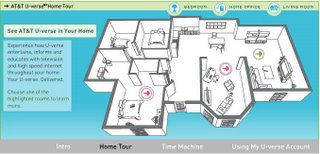AT&T has at last launched its internet-based TV service i.e. U-verse video and high-speed Internet service to about 5,000 homes in San Antonio, Texas. Texas was also chosen by Verizon for its baby steps into IPTV, called Fios TV. A comprehensive roll out won't now take place until next year. The launch follows a field trial in San Antonio, AT&T's headquarters, beginning last December. AT&T is planning to roll out service in Houston this summer as well. AT&T will be launchin U-verse in 15 to 20 markets this year where it had built out its Project Lightspeed fiber-to-the-node network. Project Lightspeed is the SBC initiative to expand its fiber-optics network deeper into neighborhoods. That delivers AT&T's U-verse TV, voice and high-speed Internet access services.
Price: Current price declared by AT&T for its U-verse service might not have the cable competition panicking about their margins just yet. The entry-level U-verse package starts at $69, and the premium service costs $114 a month. That's comparable to cable, but U-verse does, however, include internet options up to 6Mbits/s. AT&T also is offering family-oriented bundles starting at $54 a month, as well as a premium Spanish-language package for an extra $10 per month after a promotional three-month discount. The introductory installation fee is $20, down from $95. The company is offering qualified customers three months of free "live TV"
Features: The services come with three TV receivers per home, including one with a digital video recorder, and a wireless Internet router. DVRs allow viewers to pause, rewind, replay and record live TV. TVs become IP-enabled via the IPTV receivers and can be used to display digital photos and other content. AT&T's STBs will run Microsoft IP-TV software and allow users a variety of interactive functions like video recording and video on demand. U-verse includes 200 channels of IPTV, Spanish-language programming, video-on-demand, and an interactive program guide. Features exclusive to IPTV include faster channel-changes, a mosaic approach to picture-in-picture displays, and content searches via keywords such as actor names. The service is launching with DVR capabilities on one receiver but will add whole-home DVR capabilities and High Definition TV later. The U-verse service includes IPTV and high-speed Internet access. AT&T is offering access at 1.5 Megabits per second; 3Mb/s and 6 Mb/s.
Fibre Strategy:
SBC's Project Lightspeed is using VDSL-2, to reach the overwhelming majority of their homes. They deliver fiber to the node, but twisted pair copper to the home. SBC uses Alcatel gear for the fiber backbone. It consists of IP routers, the 7750, the Ethernet switches, the 7450, the remote DSLAM, the 7330. Microsoft's IPTV solution is used for the settop box. AT&T has been building a $4 billion fiber-optic network to offer television, Internet and telephone service over phone wires. The fiber-to-the-node initiative will catapault SBC into a 13-state market for voice, video and data services and is the world's largest IP-TV rollout. Alcatel is primary supplier for Project Lightspeed infrastructure in a $1.7 billion deal. Within three years, about 18 million SBC households will have access to this network.
SBC is Using the release 1.1 of Microsoft’s IPTV middleware for IPTV launch offers four standard-definition streams. It also will support three standard-definition and one high-definition video stream, and will offer more than 200 channels. It further will include double the number of VoD options available during the controlled launch and provide the same high-speed Internet access. IMS-based VoIP will become part of the service starting in December. SBC has picked IP-TV settops from Scientific-Atlanta and Motorola for the telco's planned IP-TV system. Financial terms of the two contracts were not disclosed. The contracts give equal market opportunity to both vendors and continue through the end of 2008. AT&T's Homezone subscribers will use their integrated set-top box with AT&T Yahoo broadband to access video programs and movies, as well as tap into television programming through the AT&T-DISH Network satellite service. AT&T aims to use Akimbo as another tool to expand its IPTV offerings, which include phone, data and voice services designed to compete with those offered by cable companies. company is also on the cusp of announcing an intelligent NID (iNID) for the deployment. That device would sit outside the home to terminate video and data traffic, and a residential gateway with 802.11n would sit inside the house. AT&T is using MoCA technology for in-home networking today, but HPNAv3 over twisted pair and 802.11n are where it’s planning to go on the long term, as HPNAv3 works well both for single-family homes as well as for multidwelling units, in which a cable company may own the in-building coax. HPNAv3 is integrated into the set-top boxes AT&T is using. IPTV i.e. U-verse has gone pretty smoothly for AT&T as it moves through its controlled tests and on to its commercial launch, one of the challenges was integrating the Microsoft software and other parts of the Lightspeed solution with two different iterations of set-top boxes. For the controlled launch, AT&T was using Tatung set-top boxes, but the commercial services will use Motorola Inc. and Scientific-Atlanta set-top boxes, which are based on STMicroelectronics and Sigma Design Inc. chips, respectively.
In addition to the Lightspeed effort, AT&T this month or next will commercially launch throughout its DSL footprint a new hybrid DBS/DSL service called HomeZone, which uses a 2Wire box to deliver services within the consumer’s home. HomeZone will have a similar user interface look and feel to what’s being used for Lightspeed with very comparable video quality. It will include the same channel options available today through EchoStar’s DISH, which is providing the DBS component of the service. And it will offer pay-per-view and VoD options, including a broad slate of selections AT&T will provide in collaboration with Akimbo. VoIP is not a feature of the HomeZone bundle.
Further posts will be augmented with AT&T's pricing and component strategy


1 comment:
Hello I must say this is a very nice blog you have here and the comments are very interesting as well. Being an internet afficionado I am constantly seeking out new sources of information like this one. While I am currently doing some research, I would also like to intimate the readers of this blog about the ongoing drive to sell out the internet to the big communications companies. I am part of a pressure group that would appreciate it if readers would help spread the word about this so we can maintain the intergrity of the internet as a free resource for the world. Thanks for helping to spread the word and being a resource for my work. Cheers and keep up the good work.
asset management
Post a Comment